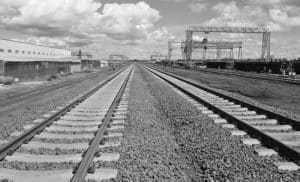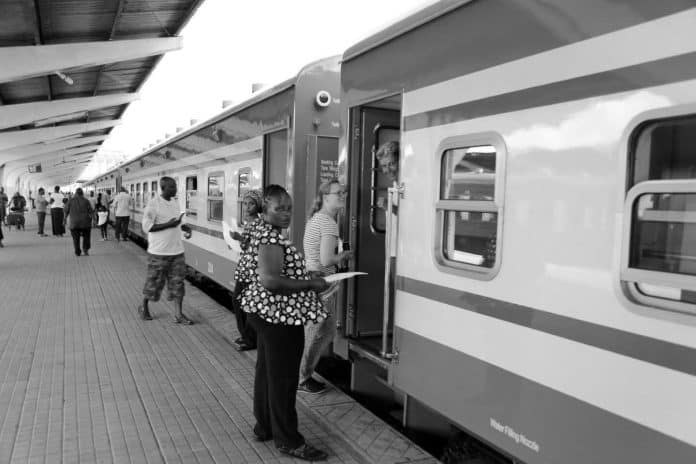Introduction to the Standard Gauge Railway (SGR)
The Standard Gauge Railway (SGR) is a revolutionary transportation infrastructure that is transforming the landscape of many African nations. This modern rail system, characterized by its standardized track width of 1,435 millimeters, offers a swift, efficient, and eco-friendly alternative to traditional modes of transportation. The SGR has the potential to revolutionize the way goods and people move, driving economic growth and fostering regional integration.
As you delve into this article, you will explore the impact of the SGR on the vibrant region of Kigoma, Tanzania. This strategic location, nestled along the shores of Lake Tanganyika, is poised to reap the benefits of this transformative infrastructure project.
Overview of Kigoma’s Transportation Infrastructure
Kigoma, a bustling hub in western Tanzania, has long been a critical juncture for transportation and trade. Historically, the region has relied on a combination of road and water-based modes of transport, including the iconic ferries that traverse the vast expanse of Lake Tanganyika.
However, the introduction of the SGR has the potential to significantly enhance Kigoma’s transportation landscape. The railway line, which is currently under construction, will connect Kigoma to the rest of Tanzania’s growing SGR network, providing a seamless and efficient means of moving goods and people across the region.
The Impact of the SGR on Kigoma’s Economy

The arrival of the SGR in Kigoma is poised to have a transformative impact on the region’s economy. By offering a reliable and cost-effective transportation solution, the railway will open up new avenues for trade, investment, and economic diversification.
- Increased Trade and Commerce: The SGR will facilitate the efficient movement of agricultural products, minerals, and other goods from Kigoma to domestic and international markets. This will enable local businesses to expand their reach, access new customers, and capitalize on emerging economic opportunities.
- Improved Logistics and Supply Chain: The SGR’s efficient transportation network will streamline the logistics and supply chain processes, reducing delivery times and costs. This, in turn, will make Kigoma a more attractive destination for businesses and investors, fostering a more vibrant and competitive economic environment.
- Diversification of Economic Activities: The improved connectivity provided by the SGR will encourage the development of new industries and sectors in Kigoma, beyond the traditional reliance on agriculture and natural resources. This diversification will create a more resilient and dynamic local economy.
- Enhanced Tourism Potential: The SGR will make it easier for travelers to access Kigoma, a region renowned for its natural beauty, wildlife, and cultural heritage. This increased accessibility will boost the local tourism industry, generating employment opportunities and revenue for the community.
Benefits of the SGR for the Local Community
The implementation of the SGR in Kigoma extends beyond economic considerations, as it also promises to deliver significant benefits for the local community.
- Improved Accessibility: The SGR will provide a reliable and affordable means of transportation for residents, connecting them to educational, healthcare, and employment opportunities across the region. This enhanced accessibility will contribute to the overall well-being and quality of life for the people of Kigoma.
- Job Creation and Skill Development: The construction and operation of the SGR will generate a wide range of job opportunities, from engineering and construction to logistics and customer service. Additionally, the project will foster skill development and capacity building within the local workforce, empowering the community and creating long-term employment prospects.
- Sustainable Development: The SGR’s environmentally-friendly and energy-efficient design aligns with the principles of sustainable development. By reducing reliance on fossil fuels and promoting greener modes of transportation, the railway project contributes to Kigoma’s efforts to build a more sustainable future.
- Social Integration and Connectivity: The SGR will enhance social integration by facilitating the movement of people, ideas, and cultural exchange across the region. This improved connectivity will foster a stronger sense of community and promote greater understanding and cooperation among the diverse populations of Kigoma and beyond.
Challenges and Considerations of Implementing the SGR in Kigoma
While the benefits of the SGR in Kigoma are undeniable, the implementation of this transformative infrastructure project is not without its challenges and considerations.
- Financing and Funding: The construction and maintenance of the SGR require substantial financial resources, which can pose a significant hurdle for developing economies like Tanzania. Securing the necessary funding from both public and private sources is crucial for the successful and timely completion of the project.
- Land Acquisition and Resettlement: The construction of the SGR may necessitate the acquisition of land and the resettlement of affected communities. Navigating these complex social and legal issues requires a delicate balance between the needs of the project and the rights of the local population.
- Environmental Impact and Sustainability: The development of the SGR must be carefully planned and executed to minimize its environmental impact, ensuring the long-term sustainability of the project. Addressing concerns related to biodiversity, water resources, and emissions is crucial for maintaining the ecological balance of the region.
- Coordination and Stakeholder Engagement: Effective coordination among various government agencies, local authorities, and community stakeholders is essential for the successful implementation of the SGR project. Fostering open communication and collaboration will help to address concerns, mitigate risks, and ensure the project’s alignment with the needs and aspirations of the Kigoma community.
The Role of the SGR in Promoting Regional Integration
The SGR in Kigoma is not just a local or national endeavor; it is part of a broader vision for regional integration in East Africa. By connecting Kigoma to the wider SGR network, the project aims to facilitate the seamless movement of goods, people, and ideas across national borders, strengthening economic and cultural ties within the region.
- Cross-Border Trade and Connectivity: The SGR will enhance Kigoma’s connectivity with neighboring countries, such as Burundi, the Democratic Republic of the Congo, and Zambia, opening up new markets and trade opportunities for local businesses.
- Improved Passenger and Freight Transport: The efficient and reliable transportation provided by the SGR will make it easier for individuals and businesses to travel and transport goods across the region, fostering greater economic and social integration.
- Strengthening Regional Cooperation: The successful implementation of the SGR in Kigoma will serve as a model for other East African nations, encouraging collaboration and the sharing of best practices in the development of modern transportation infrastructure.
- Sustainable Development and Environmental Stewardship: The SGR’s commitment to sustainable and environmentally-friendly transportation aligns with the regional goals of promoting green growth and mitigating the impacts of climate change, contributing to a more sustainable future for the East African community.
Future Plans for the SGR in Kigoma
As the SGR project in Kigoma continues to progress, there are exciting plans and possibilities for the future of this transformative infrastructure.
- Expansion and Connectivity: The current SGR line connecting Kigoma to the rest of Tanzania is just the beginning. There are plans to extend the railway network further, linking Kigoma to other major hubs in the region and enhancing the overall connectivity of the transportation system.
- Multimodal Integration: The SGR will be seamlessly integrated with other modes of transportation, such as road networks and lake-based ferry services, creating a comprehensive and efficient multimodal transportation system for Kigoma.
- Logistics and Industrial Development: Kigoma is poised to become a major logistics and industrial hub, with the SGR serving as the backbone for the movement of goods and the establishment of new manufacturing and processing facilities.
- Tourism and Cultural Exchange: The improved accessibility provided by the SGR will open up Kigoma to a wider audience of travelers, showcasing the region’s natural beauty, cultural heritage, and unique attractions to both domestic and international visitors.
Case Studies of Successful SGR Projects in Other Regions

The transformative power of the SGR is not limited to Kigoma; it has been witnessed in various other regions across Africa. By examining successful SGR projects in other parts of the continent, you can gain valuable insights and perspectives that may be applicable to Kigoma’s own journey.
- The Addis Ababa-Djibouti Railway, Ethiopia and Djibouti: This cross-border SGR project has transformed the transportation landscape, boosting trade, investment, and economic development in both countries.
- The Mombasa-Nairobi Standard Gauge Railway, Kenya: The Kenyan SGR has revolutionized the movement of goods and people, contributing to the country’s economic growth and regional integration.
- The Abuja-Kaduna Railway, Nigeria: The successful implementation of this SGR line has improved connectivity, reduced travel times, and fostered socioeconomic development in the region.
These case studies demonstrate the far-reaching benefits of the SGR, serving as inspiring examples and providing valuable lessons for the Kigoma project.
Opportunities for Investment and Business Growth in Kigoma
The arrival of the SGR in Kigoma presents a wealth of opportunities for investment and business growth in the region. As the transportation infrastructure becomes more efficient and reliable, the stage is set for a surge of economic activity and entrepreneurial ventures.
- Agribusiness and Food Processing: Kigoma’s rich agricultural potential, coupled with the SGR’s ability to facilitate the movement of goods, makes the region an attractive destination for investment in agribusiness and food processing industries.
- Logistics and Transportation Services: The SGR will create a demand for specialized logistics and transportation services, such as warehousing, freight forwarding, and supply chain management, presenting opportunities for entrepreneurs and businesses to capitalize on this growing industry.
- Manufacturing and Industrial Development: The improved connectivity and access to markets provided by the SGR will encourage the establishment of manufacturing and industrial facilities in Kigoma, diversifying the local economy and creating new employment opportunities.
- Tourism and Hospitality: The increased accessibility of Kigoma’s natural and cultural attractions, enabled by the SGR, will spur investment in the tourism and hospitality sectors, from hotels and resorts to tour operators and leisure activities.
- Real Estate and Infrastructure: The anticipated growth and development in Kigoma will drive demand for real estate and infrastructure projects, such as residential and commercial developments, as well as supporting infrastructure like roads, utilities, and telecommunications.
Conclusion: The Transformative Power of the SGR in Kigoma
The Standard Gauge Railway (SGR) in Kigoma represents a transformative opportunity for the region, one that holds the potential to unlock new avenues of economic growth, social development, and regional integration. By enhancing transportation efficiency, fostering trade and investment, and improving the quality of life for the local community, the SGR is poised to be a catalyst for positive change in Kigoma.
For more articles related to Railway and train travel Tanzania, click here!

































